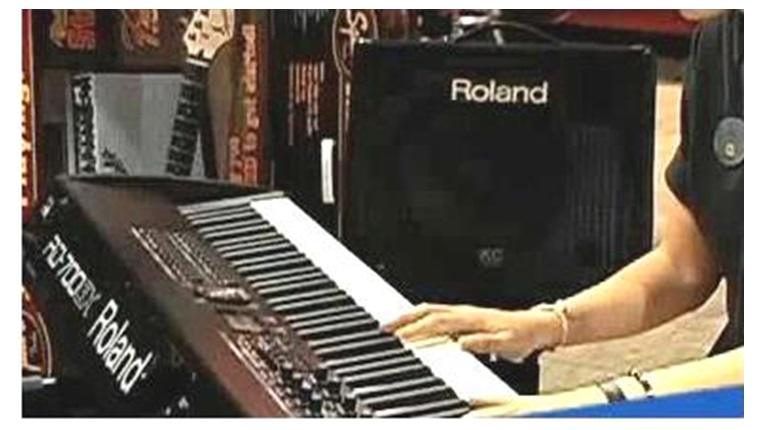
Keyboard amp buying guide: Know what to look for in a keyboard amplifier and how does it differ from a Guitar, Bass or any other amp. Keyboard amps cover a wider frequency range than guitar amps, and put you in control of your keyboard rig’s sound. Top-end electric piano/Keyboards come with excellent cutting edge sounds, you need to use external amplifier to hear their outstanding sound quality. Learn more so that you get a dedicated amplifier for your digital piano keyboard.
Introduction
Pro digital keyboards (also referred to as electric keyboards/ stage pianos) are used primarily for live onstage performances. These keyboards have professional features, pack lot of power and are compact enough to carry in your vehicle. Because of their professional features, you can use them on-stage or in the studio.
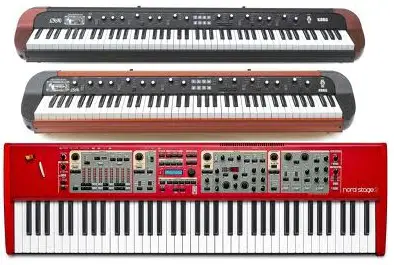
But what about speakers…do you require external amplification for these pro electric keyboards?
Do You Need External Speakers?
Some high-end keyboards (such as those from Yamaha) have built-in speakers, which is good enough for home use or if you are just hearing out your compositions.
But if you intend to use your electric keyboard for professional use, it makes sense to use it with an external amplifier to hear out its true capabilities.
Here’s more on Keyboard Amplifiers/external speakers and how to use them with digital keyboards.
How is a Keyboard Amp different from Amps for other instruments?
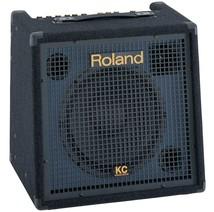
If you already play with other musicians, you would know that bass players only have to think about the root notes they play, the guitar players usually play the chords or melody.
However, if you’re keyboard player in a smaller group of musicians, it’s quite likely that you are:
And, even if you have the skills to play all those, it’s also important for the gear to make them sound as well.
That’s why you need a keyboard amplifier that is good enough to reproduce the sound across a wide range of octaves.
Choosing a Suitable Amp
In case you play for gigs, you can either be dependent on the PA available at the venue for keyboards (doesn’t give you much control) or you could use a good quality keyboard amp that gives you a lot more control over your keyboard’s sound when on stage.
Most keyboard players also struggle to hear what they are playing when onstage, that is where some of these amps can actually be quite useful as they also make an excellent personal monitor, while you use its Line Out jack to run your rig into the PA.
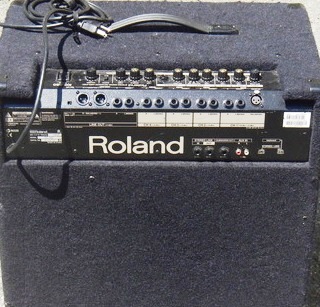
When choosing a keyboard amplifier, it’s important to select one that is capable of producing shimmery top end, punchy midrange, and thumping bass.
Besides, it also needs transportable and also loud enough to compete with the rest of the musical instruments present on stage.
In case you want a compact, multi-purpose sound system, go in for something that works well with voice, microphones, keyboards, acoustic and electric guitar, drum machines and backing machines, such as CD and DAT players.
You also get amps that are capable of adding effects, and come with additional features such as loop, ground lift, master level, XLR balanced stereo line out, and the capability to drive an external speaker.
Using a Common Amplifier
There are good reasons why a common amplifier is not used for all musical instruments.
Musical instruments have their own qualities and an Amplifier should take that into consideration while amplifying.
So if you were thinking of using a guitar amp or a bass amp for your digital piano-keyboard, just because it is available or if you are getting it cheap, think twice.
Read here for reviews of Keyboard Amplifier Brands / Models
Here are some of the unique aspects of different instrument amplifiers, compared to a Keyboard Amp.
Guitar Amps
The Standard Ones
Guitar amps are supposed to deliver sounds ranging from a clean, warm sound (used in soft rock or country) to a roaring, natural overdrive, especially when the volume is set near maximum.
Another important task for a guitar amp is to reduce the extreme high frequencies (on the treble side) and to reduce the boom (on the bass side).
So these amplifiers have a sharp treble cut-off at around 5 kHz and a bass roll-off at around 60–100 Hz.
For Hard rock and Heavy Metal
For this style of music, you need an aggressive intensity to the guitar sound at higher frequencies, and that too with distortion effects. So, on these amps you will find distortion effects, pre-amp boost controls, and tone filters.
Can you use Guitar Amp for Keyboard?
A keyboard amp usually has a woofer (for bass), a tweeter (for high-frequency sound) and a midrange speaker in one cabinet.
Guitar amps, on the other hand, are designed to cut bass response, boost the midrange, and on the high frequency side don’t go much beyond 10kHz.
So if you use a guitar amp for your digital keyboard, your digital keyboard sound will be squeezed into the guitar’s frequency range, which is much smaller than a keyboard’s sonic range.
The result will be less clarity and lower volumes.
Bass Amplifiers
Again, don’t assume a guitar amplifier will do justice to a Bass amplifier. A Bass amplifier differs from regular electric guitar amplifiers in many ways.
A Bass amplifier has extended bass response and tone controls, which is optimised for bass instruments that produce pitches as low as 40 Hz.
The more expensive, high-end bass amplifiers usually include compressor or limiter feature, which is included to eliminate distortion at volumes near maximum.
Acoustic Amplifiers
An Acoustic amplifier is meant for acoustic instruments such as violin, fiddle, mandolin, acoustic guitar, basically instruments use for quiet genres like classical, pop, country, folk and bluegrass.
Like a keyboard amp, these are designed to deliver relatively flat frequency response, without introducing any additional tonal coloration.
What you need is a clean sound here, so the amplifiers have to be powerful to prevent unwanted distortion.
Keyboard Amp
As mentioned earlier, a keyboard amp has to work with a wide frequency range. Hence, it contains a large woofer (for bass notes), a tweeter horn (for high-frequency notes) and a midrange speaker in one cabinet.
A keyboard amplifier can be used with a range of digital, electric and electronic keyboard instruments, such as synthesizers, Hammond organ-style keyboards, digital stage pianos and electric/digital pianos.
These amplifiers have very low distortion and give extended, flat frequency response for both, bass and treble clef notes.
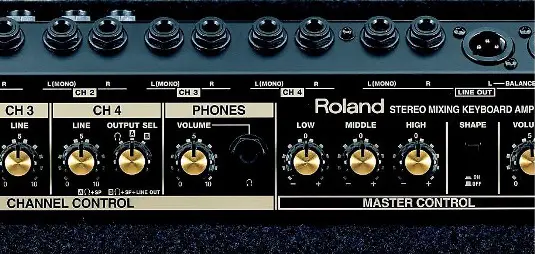
Note: If you need a keyboard amp for Hammond organ, you may need to go in for one that is specifically made for Hammond organ, since these amps will need to add a warm, roaring overdrive to the organ sound.
For certain genres of music, such as progressive rock, keyboardists love to perform with several synthesizers, electric pianos, and electro-mechanical keyboards.
For such reason, certain keyboard amplifiers come with a simple onboard mixer with multiple inputs, so that keyboardist players can control the tone and level of several digital piano-keyboards using this keyboard amp.
So here are the important features:
- Keyboard amps are a great way to make your sound stand apart, when you’re sharing the stage with a large ensemble
- It’s a must-have for solo gigs in makeshift venues that lack a decent sound system
- They can also make an excellent personal monitor when onstage
- Most also have the ability to add various stereo effects (presets)
- They also include a dedicated multi-band EQ for sound shaping.
- Most of these are suitable for keyboards, voice, mics, drum machines and backing machines (CD and DAT players)
- Separate headphone output is usually provided silent practice.
- you can also connect a CD player to the amp and play along.
Here’s a video demo of a Keyboard amplifier:
Feedback Problem
In certain cases, when you connect a microphone to the XLR input of a keyboard amp, you might experience feedback (On some amps, when feedback occurs, you can see LEDs light up).
To reduce/eliminate that, you need to place your equipment in the right manner:
Don’t point the speakers at the pickup of the mic.
There are many occasion where, if you’re playing in a band, you could experience that your keyboard gets cut out (no sound produced) all of a sudden.
Now there could be a couple of reasons for that:
If you are adjacent to a guitarist (using his/her own amp and at louder levels) then you might get the impression that there’s no no sound coming out of your amp. Though it might not be the case, it’s best to move away from the guitarist’s amp (to make sure there’s no interference from the other amplifier).
If the problem still persists (even after moving away), then in most probability, your amp could have gone faulty.
Choosing the Right Specs
You need to choose an equipment with the specs and something that’ll suit your requirements.
So for instance, if you have an amp with a smaller mid-range speaker (and is a 1-way audio system), then it’ll work best with a single audio source – be it vocals, an instrument or a CD player, to get the best possible midrange.
So if you plan to connect a CD player, another instrument and use the XLR channel to sing, then the results may not be the best.
As soon as you start playing multiple audio sources through it, because it’s not a 3-way audio system, you’ll start noticing the problems. The sources will start “competing” for volume, with the loudest source suppressing the quieter sources. The problem becomes even more pronounced if you turn up the volume.
That’s why you should upgrade to a product with better specs.
Mystery of Wattage
As far as the wattage goes, you need to understand that most of the time it’s a marketing gimmick. Most manufacturers just use different terms to give an impression that the product has a higher power rating, whereas in reality it’s not exactly true.
So for example, if an amplifier has four 75W channels, most salesmen will market it as 300W of power(4 x 75W = 300W). Though mathematically it may sound right, it really won’t sound like 300 watts.
The important thing that you should note is that a single channel equals 75W of power. If you’re going to use just one channel (for playing the piano), and play with other musicians in a band, you’re only going to get 75W.
Having said that, a keyboard amp with 300W (75W per channel) will always be powerful compared to a 180W (45W per channel), and also more expensive.
Another good thing about amplifiers is that you can always chain them up for more power.
So you can have a couple of workable scenarios if you nee dmore power:
Why does a Keyboard Amp contain different types of speakers (woofer, tweeter, etc.)?
Since a keyboard amp has to amplify a wide range of frequencies, a keyboard amplifier is built-up of several small speakers. A keyboard amp internally houses various speakers named as woofer, tweeter and some other speaker. We all want a well-rounded sound from the speakers. when you hear a song, you want all the frequencies to be clearly audible. So even though speakers are used for sending out sound, a woofer is used to clearly project the low bass sound and a tweeter is used to properly project the high treble sounds.
More Videos that show Keyboard connection to an Amplifier.
All About Cost
Upgrading to a better product will cost more, but then you have to pay for a better quality.
The reliability of a product is usually associated with the cost of the equipment. In case you buy a really cheap product, you need to bear in mind that you may have to start your search all over again, and buy another one, in a few years time.
When you compare brands such as Behringer and Roland, you’ll notice that most Behringer amps are cheaper compared to Roland.
So does that mean Roland is a better product?
Well, they do have a better brand name, their amps are rock sturdy (suited for gigs), and they have been making amps for quite some time now.
Behringer on the other hand, is more into controllers and audio equipment. Besides, they are better at “reverse engineering”. They don’t do lot of research and development; they just breakdown the equipment of other manufacturers to understand the basics, and then put it together under a different name. That’s one of the reasons their products are cheaper.
Now, that’s not a bad thing for you as a customer, because you still get comparatively better quality products at affordable prices.
Various Keyboard Amp Brands / Models
- Best Keyboard Amps
- Roland Keyboard Amplifier review
- Motion Sound Keyboard Amplifiers review
- Peavey Keyboard Amplifiers review
- Behringer Keyboard Amplifier review
Checkout the bestselling Combo Keyboard Amplifiers
Keyboard Amplifier: Frequently Asked Questions (FAQs)
Use Keyboard Amp or Powered Monitors with digital piano keyboard for Studio Use?
Here’s another question: I have been spending some time on acquainting myself with computer music, and I now intend to use my Roland V-piano digital piano for music production at home. I do not intend to take my piano for gigs or outdoor performances. What would be a good pair of speakers to buy? Would Keyboard amps still make sense or shall I need to go in for Powered studio monitors for my Roland V-piano – Jason (Sydney, Aus)
Answer: Keyboard amps are convenient but usually don’t deliver great sounds when performing live. If you’re going to use your keyboard in the studio all the time, studio monitors would be a good bet, Just pick up a couple of powered monitors, and it should fill up the room with good sound. A good 160 watts speaker should be able to produce good bass without any distortion at loud volumes. You should ideally use a mixer where everything goes, so that you can easily tweak the EQ to get the best possible sound.
Getting the right sound is definitely a challenge for many. What many don’t realize is that getting a keyboard/DP worth a few grands is not automatically going to give you top notch sounds. You also need to spend on a good sound system.
A problem with using studio monitors for live playing is that you possibly blow it up by over-driving them, trying to compete with the other musicians such as the drummer or the bass player. Obviously, the studio monitors are not built for that purpose.
However, most of these speakers are not as sturdy (or protected or grilled) like a keyboard amp. So you have to be really careful in case you take the speakers out for live playing, the studio monitors are not really built for the road.
Use Keyboard Amp or Powered Monitors or PA System for Your Keyboard?
Getting the right sound from your keyboard can be tricky, especially in live playing situations. Depending on the venue, number of musicians there in the band, there are various choices available to you – keyboard amp, powered monitors or using a PA system. Each have their advantages and their are various ways in which these can be incorporated in a live rig.
Ask any experienced musician and he/she would agree that at the end of the day, it really doesn’t matter much what you use, as long as you can hear it properly, the audience can hear it properly and its easy to carry around.
Here are few more things to know about Keyboard Amp, Powered Monitors & PA System:
- Most musicians prefer to have their own monitor, independent of the PA system, so that they can hear themselves.
- When onstage, you could split your keyboard output to your own monitor and to the PA.
- Musicians in the band can also share the same mix over different physical monitors
- Most keyboardists stand behind the vocalists so they can hear their monitors enough to play-along with the drums and bass.
- With active monitors, you can easily chain the same mix from one monitor to another (almost all the active monitors have a second socket for this). With passive monitors, you need to be mindful of speaker-load on the amps.
- Keyboard amps are convenient to carry, are rugged, and can be used for self-monitoring
- To get the best sound quality, its advisable to stay away from the cheapest self-powered speakers
Most musicians use the keyboard amp for self-monitoring and stage volume (for the rest of the band), but the output of the keyboard is given to the PA for better live sound
Keyboard Amps Not Great for Live Piano Keyboard Playing?
Questions: I own a Yamaha P-95 piano and they sound just awesome through my Sennheiser headphones. I am looking for a suitable keyboard amplifier for my p95. I have heard reviews that keyboard amps don’t help much for live keyboard playing, and there are some recommendations for PA systems. What should be the setup like if I decide to go in for a PA system (as opposed to a keyboard amp) for live keyboard playing?
Answer: The most convenient thing to use is a keyboard amp, but as many musicians experience, you may not necessarily get the best possible output (which you may expect if you have a keyboard that’s worth 3k dollars), unless you invest in a really good one. Having said that, keyboard amps are quite easy to setup and are built for the road, which makes them suitable for gigging. A better option is to go in for ‘Active PA type speakers’. A good pair of active speakers (such as the 2 way, 12″ EV SXA 360s) can easily cost around $1600-1900 for a new pair but they’re able to generate the best sounds for your keyboards. Its not that keyboard amps are bad, they actually sound good but are more biased towards ‘keyboard sounds’ such as electric pianos, rhodes, clav, organ & even synth sounds. For any other sound, it’s probably going to sound harsh. – Mario (Manila, Philippines)
Answer: Depending on the venue, a keyboard amp would be the best choice. The Roland, Behringer and Motion Sound amps have a really good sound for most any type of keyboard sound (the motion sound amps are amazingly loud but clear!) I use a pair of JBL EON 10″ speakers which could also be used with a mixer as a small PA. Plus an amp would be easier to drag around for rehearsals or small coffee-shop sized gigs. My 2 EONS are fine for self-monitoring for large concert venues and more than likely, there would be a supplied PA anyways! Don’t use a guitar or bass amp. They are not designed for the full range that keyboards cover. Basically the budget breaks down as, Behringer – Low, Roland – Mid and Motion Sound – High. Hope this helps! – KCJazzKeys
Answer: A PA system (full range speaker) like the Yamaha STAGEPAS system will sound right, and can be used for both home-use as well as for gigging purposes. I play keys and digital horn for several groups with a variety of styles. I’ve owned several keyboard amps Roland, Yorkville, Peavey, and Crate over several years. When talking with other keyboardist most of us agree that PA systems give you a broader range of versatility. I’m currently using a Fender Passport 500. The Passport s 500 watt stereo 8 channel system with 2 10″ speaker/horn that’s awesome it’s about 43pounds and packs up like a suitcase. Most keyboard players are going that route – more inputs, low ans hi-z power, portability and great sound. I used it in church with a portable B3 Hammond, Korg and Roland Keyboard with about 350 people in a midsize room. It was more than enough at half volume. If you’re a keyboardist it’s worth checking out. – SC Law
Do You Need Two Keyboard Amps to Get Stereo Output from Your Digital Piano Keyboard?
One of our users had a question: I have a Yamaha DGX 640 keyboard and am looking for suitable amplification. What would be a suitable keyboard amplifier to buy? I intend to take my DGX-640 for gigs and want some nice punch from my amps. I have heard that one amplifier may not be enough for this purpose, and one needs to go in for two keyboard amps to get a true stereo sound. Is that true? Do both the keyboard amps need to be of the same wattage in that case? – Martin (Brighton, UK)
Answers: There are a few amps that will give you full stereo image – some Roland and some Traynor amps ; both are a bit expensive. Generally you’ll find mono amps out there, with good results. Manufacturers actually are including a feature called ‘stereo link’ which allows you to connect two of those mono amps in order to obtain the stereo image mentioned before, one amp acting as left channel and the other one as the right channel.
What Sounds Best On A Portable Digital Piano Keyboard: Speakers, Headphones or External Amplifiers?
There are several ways in which you can hear the various voices and styles on a digital piano keyboard – Built-in speakers, Headphones or External amplifiers.
Most piano keyboards have built-in speakers (high-end stage pianos like synthesizers and workstations do not usually come with built-in speakers), but all of them have jacks for connecting headphones. The built-in speakers of most beginner keyboards and pianos sound okay, but there’s a way to make them sound better.
Get a good pair of headphones and your piano keyboard will sound better. Why? Because even though the speakers may not be of very good quality, the sound samples used are good and that’s why they sound good on better headphones or external speakers.
Though the quality of built-in speakers of home keyboards is becoming better by the day, if you want more options, you may use headphones. A better option is to connect it to your home music system, if you have a hi-fi music system.
For gigs and live keyboard playing (for smaller venues), you may consider using a keyboard amplifier.
KeytarHQ editorial team includes musicians who write and review products for pianists, keyboardists, guitarists & other musicians. KeytarHQ is the best online resource for information on keyboards, pianos, synths, keytars, guitars and music gear for musicians of all abilities, ages and interests.



Leave a Reply